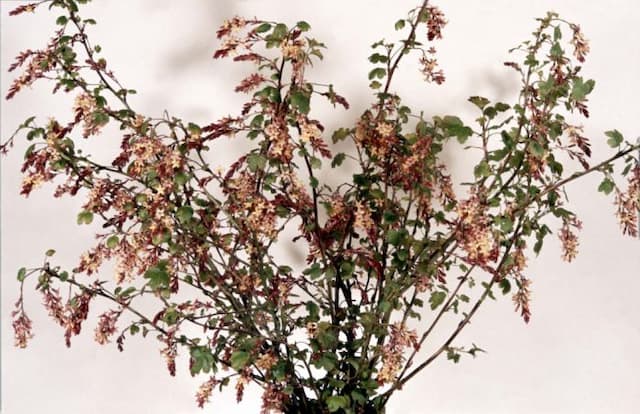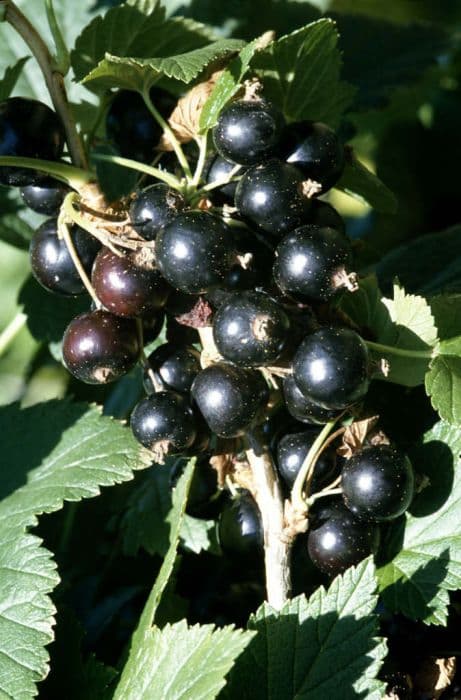White flowering currant Ribes sanguineum 'Tydeman's White'

ABOUT
The Ribes sanguineum 'Tydeman's White', commonly known as the white flowering currant, is an ornamental shrub that is admired for its decorative qualities. It has a dense and bushy appearance, often forming a rounded shape with many branches. The leaves are typically three-lobed and have a deep green color, which creates a lush backdrop for the blooms. The most striking feature of this plant is its flowers. The 'Tydeman's White' variety produces clusters of white flowers that dangle elegantly from the branches. These flowers are small, tubular, and hang in racemes, creating a pendulous effect that can be quite eye-catching. The bloom time is generally in the spring, when the shrub becomes a focal point in the garden. As the flowers fade, they are followed by berries that can attract birds and wildlife to the garden. The berries are usually not a prominent feature for the 'Tydeman's White' as they are with some other currant species. The white flowering currant has a reputation for being hardy and can fit well into a variety of garden settings, contributing to its popularity among gardeners. It is commonly used as a specimen plant, in borders, or as part of a shrubbery collection, bringing a touch of elegance with its white blossoms.
About this plant
 Names
NamesFamily
Grossulariaceae.
Synonyms
White Flowering Currant, White Icicle, Blood Currant.
Common names
Ribes sanguineum var. glutinosum, Ribes sanguineum var. helleri, Ribes sanguineum var. sanguineum
 Toxicity
ToxicityTo humans
Red-flowering currant (Ribes sanguineum 'Tydeman's White') is not commonly known to be toxic to humans. There is little to no evidence suggesting typical interactions with this plant would be harmful if it is touched or ingested in small quantities. However, as with many plants, individual sensitivities and allergic reactions are possible, and it is generally advisable to avoid eating ornamental plants unless they are known to be safe for consumption.
To pets
Red-flowering currant is also not widely recognized as toxic to pets. This plant doesn't appear on common toxic plant lists for dogs and cats, implying that it is not known to cause serious harm if pets ingest small amounts of it. However, like with humans, pets may experience stomach upset or an allergic reaction if they ingest part of this plant, so it's wise to discourage pets from eating ornamental plants.
 Characteristics
CharacteristicsLife cycle
Perennials
Foliage type
Deciduous
Color of leaves
Green
Flower color
White
Height
6 feet (1.8 meters)
Spread
6 feet (1.8 meters)
Plant type
Shrub
Hardiness zones
6
Native area
North America
Benefits
 General Benefits
General Benefits- Aesthetic Appeal: Ribes sanguineum 'Tydeman's White', commonly known as Flowering Currant, offers striking white flowers that enhance the visual appeal of any garden space.
- Wildlife Attraction: The plant is attractive to bees, butterflies, and birds, encouraging biodiversity in the garden.
- Low Maintenance: Flowering Currant is relatively easy to care for, requiring minimal upkeep once established.
- Drought Tolerance: Once established, it has a good level of drought resistance, making it suitable for xeriscaping.
- Seasonal Interest: The plant provides year-round interest with flowers in spring and foliage changes in autumn.
- Privacy Screen: Its growth habit can provide a natural screen or hedge, offering privacy and reducing noise pollution.
- Erosion Control: The dense root system can help stabilize slopes and prevent soil erosion.
- Adaptability: It can adapt to a range of soil types, although it prefers well-drained soil.
- Cold Hardy: Flowering Currant is capable of surviving in cooler climates, making it a robust choice for northern gardeners.
 Medical Properties
Medical PropertiesThis plant is not used for medical purposes.
 Air-purifying Qualities
Air-purifying QualitiesThis plant is not specifically known for air purifying qualities.
 Other Uses
Other Uses- Ribes sanguineum 'Tydeman's White', commonly known as white-flowering currant, can be used as a natural dye. The flowers and foliage can provide soft shades to textiles when used in traditional dyeing processes.
- The branches of white-flowering currant can be used in floral arrangements for their eye-catching white blossoms, offering a touch of elegance and spring-like feel to indoor decorations.
- Due to its dense growth habit, white-flowering currant can be planted as a privacy screen in gardens, providing a natural barrier that is both functional and aesthetically pleasing.
- Its nectar-rich flowers can be a resource for making specialty honey when placed near beehives, possibly imparting subtle flavor notes unique to this plant.
- The white-flowering currant is suitable for bonsai cultivation, allowing gardeners to create miniature landscapes with this attractive shrub.
- The thick foliage can serve as a backdrop for contrasting plants in mixed borders, highlighting the surrounding colors and textures in a garden design.
- Wildlife photographers may plant white-flowering currant to attract and photograph birds, particularly hummingbirds, which are drawn to the nectar-rich flowers.
- Its tough and adaptable nature makes it a suitable choice for urban landscaping, providing greenery in areas affected by pollution and urban stress.
- Garden educators can use the white-flowering currant to teach about plant life cycles and pollination due to its distinctive flowering and fruiting patterns.
- As part of a sensory garden, the light fragrance of its flowers can contribute to a relaxing and therapeutic outdoor environment for visitors to enjoy.
Interesting Facts
 Feng Shui
Feng ShuiThe Redflower Currant is not used in Feng Shui practice.
 Zodiac Sign Compitability
Zodiac Sign CompitabilityThe Redflower Currant is not used in astrology practice.
 Plant Symbolism
Plant Symbolism- Passion: The genus Ribes, which includes 'Tydeman's White', often carries connotations of passion and enthusiasm, as suggested by its vibrant flowers.
- Spring Renewal: As a spring-blooming shrub, 'Tydeman's White' signifies the renewal and rebirth that come with the season.
- Temporal Beauty: The fleeting beauty of its blossoms represents the transient nature of life, emphasizing the importance to cherish each moment.
- Prosperity: With its lush growth and generous flowering, 'Tydeman's White' can symbolize prosperity and abundance.
 Water
WaterThe Flowering Currant should be watered deeply and thoroughly, ensuring the soil is moist but not waterlogged. Initially, water the plant once a week with about 1-2 gallons, depending on the weather conditions and soil drainage. Once established, it may require less frequent watering, mainly depending on rainfall and temperature, but generally once every two weeks should suffice. During the heat of summer, you may need to increase watering to compensate for drier conditions. It's important to avoid overwatering to prevent root rot.
 Light
LightFlowering Currant thrives in full sunlight to partial shade. It performs best when it receives at least six hours of direct sunlight each day, but it can also tolerate some shade, especially in hotter climates. Ideally, the plant should be placed in a spot where it can enjoy the morning sun and be protected from the intense afternoon heat.
 Temperature
TemperatureThe Flowering Currant prefers moderate temperatures and can withstand a range of conditions. It can survive minimum temperatures down to around 20 degrees Fahrenheit. The ideal growing temperatures for this plant are between 60 to 75 degrees Fahrenheit. However, it is quite hardy and can tolerate colder winters once established.
 Pruning
PruningPruning the Flowering Currant is essential for maintaining its shape and encouraging healthy growth. Prune after flowering, typically in late spring or early summer, by removing dead or diseased branches and thinning out overcrowded areas to increase air circulation. Every few years, cut back older stems to promote new growth and rejuvenate the plant. The best time for a more significant pruning is immediately after the plant has finished blooming.
 Cleaning
CleaningAs needed
 Soil
SoilThe White Flowering Currant prefers well-draining, loamy soil enriched with organic matter. A soil pH of 6.0 to 7.0 is ideal. Mix in compost or peat moss to enhance fertility and structure.
 Repotting
RepottingThe White Flowering Currant generally does not need frequent repotting and can be done every 2 to 3 years or when it outgrows its current pot.
 Humidity & Misting
Humidity & MistingThe White Flowering Currant thrives in moderate humidity levels but is adaptable to different humidity conditions in the garden setting.
 Suitable locations
Suitable locationsIndoor
Place in bright, indirect light and keep moderately moist.
Outdoor
Plant in partial shade to full sun and water regularly.
Hardiness zone
6-9 USDA
 Life cycle
Life cycleRibes sanguineum 'Tydeman's White', commonly known as the White Flowering Currant, begins its life cycle when the seeds germinate in moist, well-drained soil, usually in spring or early summer. The seedlings grow into young shrubs with characteristic lobed leaves; this juvenile stage can last for several years as the plant establishes itself. Once mature, the White Flowering Currant enters its flowering stage in early spring, revealing clusters of white flowers that attract pollinators. Following pollination, the flowers develop into small, blue-black berries by late summer, which are often consumed by birds, aiding in seed dispersal. Each year, the shrub goes through a period of dormancy in the winter, shedding its leaves and entering a rest phase before the cycle begins anew with spring growth. The White Flowering Currant can live for many years, going through this cycle annually, with mature shrubs reaching several feet in height and spread.
 Propogation
PropogationPropogation time
Early Spring
The Flowering Currant 'Tydeman's White' is best propagated by softwood cuttings, which is a popular method employed for this plant. In late spring or early summer, when the new growth is mature enough yet still pliable, cuttings are taken. It's important to select healthy, non-flowering shoots and make cuttings about 4-6 inches (10-15 cm) long. The lower leaves should be removed, and the cut base can be dipped in rooting hormone before planting in a mix of peat and perlite or sand to encourage root development. These cuttings should be placed in a warm, humid environment out of direct sunlight, and rooted cuttings can usually be transferred to individual pots after a few weeks, once they show signs of new growth.








